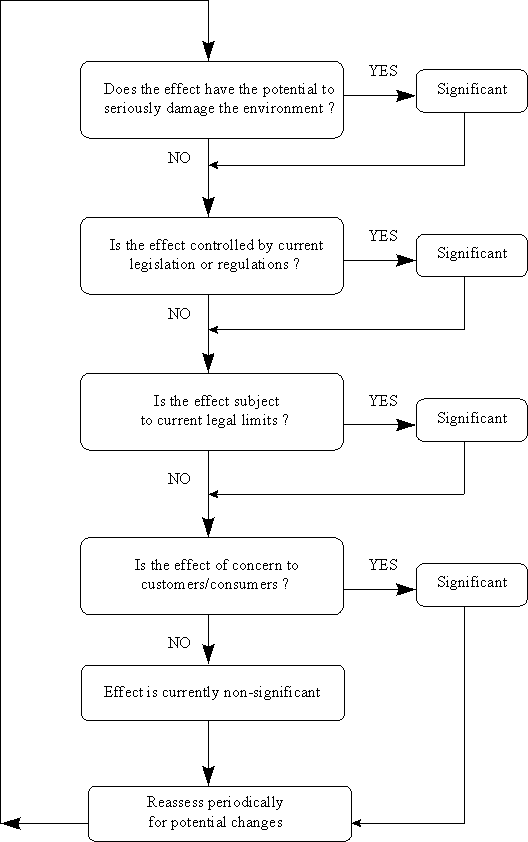|
|

|

|
Significance Evaluation MethodsThere are currently a plethora of evaluation tools that have currently been developed, and all have their advantages and drawbacks. It is the decision of the company as to which method is to be adopted although it is recommended that it is not too complicated. The company may decide to wish to tailor a method to suit there own requirements, for example, they may wish to alter the wording, or even to devise a method themselves. It is beyond the scope of this module to provide an exhaustive list, although the examples below will give you a good idea of the methods available. Method 1 A simplistic approach is given in the flow chart below to firstly assess significance, and then to evaluate significance through using a scoring method. View an example of a completed Register of Effects using this method. |
|

|
|
|
If an effect is assessed to be significant, the following method shall be applied to indicate how significant this effect is : Evaluating Significance The environmental impacts shall be evaluated to determine their significance as follows: Firstly, a score from 1 to 3 shall be assigned on the probability of the impact occurring |
|
| 1 | Unlikely to happen during normal, abnormal or emergency situations |
| 2 | May happen during normal operations |
| 3 | Certain/almost certain to occur during normal operations |
|
Next, a score from -3 to 3 shall be assigned on the severity of the impact |
| -3 | Will cause a highly significant reduction in environmental damage |
| -2 | Will cause a significant and measurable reduction in environmental damage |
| -1 | Will reduce environmental damage to a limited extent |
| 1 | Has the potential to cause limited damage to the local and global environment |
| 2 | Will result in damage to the environment |
| 3 | Will result in a major environmental incident |
|
Finally, multiply the probability and severity scores together to get a Significance Index. Adverse environmental impacts are represented by a positive score (+), whereas beneficial impacts are represented by a negative score (-). Impacts with an Index number equal to or lower than -6, or equal to or greater than 6 are considered to be significant. |
|
Method 2 For each impact identified you should award a score to show the relative performance under normal operating conditions of: |
|
|
The matrix given below gives an example how effects can be given scores/ratings under normal operating conditions. |
|
Matrix to score environmental effects under normal operating conditions |
||||||||
| Score | Weighting Factor | |||||||
| Legislation | Existing | Impending | None | X | 2 | = | A | |
| Environmental impact | Known detriment | Possible detriment | Limited detriment | No detriment | X | 3 | = | B |
| Interested parties | Considerable interest | Moderate interest | Little interest | No interest | X | 2 | = | C |
| Quantity | High | Medium | Low | Nil | X | 3 | = | D |
| Normal operating conditions total score = (A+B+C+D) | ||||||||
|
The same type of table can be used to assess the significance under other operating conditions to show the impact of: |
||||||
|
||||||
|
These four scores can then be added together to give a total score (table 4) which can be used to rate and rank the effects under the different operating conditions. |
||||||
|
Matrix to score environmental effects under different operating conditions |
||||||
| 12 | 6 | 3 | 0 | |||
| Abnormal operations | Increased environmental impact | No change | Reduced environmental impact | = | A | |
| Accident/emergency | Increased environmental impact | No change | Reduced environmental impact | = | B | |
| Historical activities | Evident/requires action | Possible damage/difficult to evaluate | No damage | = | C | |
| Planned activities | Increased environmental impact | No change | Reduced environmental impact | = | D | |
| Total score of other operating conditions = (A+B+C+D) | ||||||
|
Once you have established a score for each effect, it is up to you to finally establish the overall significance of effect using your knowledge of the company and the site. Format of the Register The company should decide the format of the register itself, although it is a good idea to have it in the same style as the Quality Assurance (QA) manual and Health and Safety (H&S) manual, especially if the systems are to become integrated.
View Examples: Maintaining the Register
The register should be periodically reviewed by the environmental management team and updated to reflect any changes in the environmental baseline situation.
|